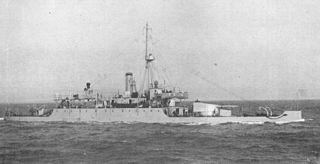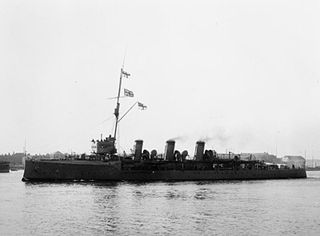
HMS Erebus was a First World War monitor launched on 19 June 1916 and which served in both world wars. She and her sister ship Terror are known as the Erebus class. They were named after the two bomb vessels sent to investigate the Northwest Passage as part of Franklin's Lost Expedition (1845-1848), in which all 129 members eventually perished.

The M29 class comprised five monitors of the Royal Navy, all built and launched during 1915.

HMSM33 is an M29-class monitor of the Royal Navy built in 1915. She saw active service in the Mediterranean during the First World War and in Russia during the Allied Intervention in 1919. She was used subsequently as a mine-laying training ship, fuelling hulk, boom defence workshop and floating office, being renamed HMS Minerva and Hulk C23 during her long life. She passed to Hampshire County Council in the 1980s and was then handed over to the National Museum of the Royal Navy in 2014. A programme of conservation was undertaken to enable her to be opened to the public. HMS M33 is located within Portsmouth Historic Dockyard and opened to visitors on 7 August 2015 following a service of dedication. She is one of only three surviving Royal Navy warships of the First World War and the only surviving ship from the Gallipoli Campaign.

HMS Mersey was a Humber-class monitor of the Royal Navy. Originally built by Vickers for Brazil and christened Madeira, she was purchased by the Royal Navy in 1914 on the outbreak of the First World War along with her sister ships Humber and Severn.
Nine ships of the Royal Navy have been named HMS Severn after the River Severn:

The Abercrombie class of monitors served in the Royal Navy during the First World War.

The Erebus class of warships was a class of 20th century Royal Navy monitors armed with a main battery of two 15-inch /42 Mk 1 guns in a single turret. It consisted of two vessels, Erebus and Terror, named after the two ships lost in the Franklin Expedition. Both were launched in 1916 and saw active service in World War I off the Belgian coast. After being placed in reserve between the wars, they served in World War II, with Terror being lost in 1941 and Erebus surviving to be scrapped in 1946.

The Battle of the Rufiji Delta was fought in German East Africa from October 1914–July 1915 during the First World War, between the German Navy's light cruiser SMS Königsberg, and a powerful group of British warships. The battle was a series of attempts, ultimately successful, to sink the blockaded German light cruiser.

The Marshal Ney class was a class of monitor built for the Royal Navy during the First World War.

HMS Marshal Soult was a Royal Navy Marshal Ney-class monitor constructed in the opening years of the First World War. Laid down as M14, she was named after the French general of the Napoleonic Wars Marshal Nicolas Jean de Dieu Soult. She served in both World Wars and was decommissioned in 1946.

The Humber-class monitors were three large gunboats under construction for the Brazilian Navy in Britain in 1913. Designed for service on the Amazon River, the ships were of shallow draft and heavy armament and were ideally suited to inshore, riverine and coastal work but unsuitable for service at sea, where their weight and light draft reduced their speed from a projected twelve knots to under four. The class comprised Humber, Mersey and Severn. All three were taken over by the Royal Navy shortly before the outbreak of the First World War and were commissioned as small monitors. All three saw extensive service during the war and were sold in 1919.

HMS Skirmisher was one of two Sentinel-class scout cruisers built for the Royal Navy during the first decade of the 20th century. Completed in 1905 the ship was placed in reserve until she was commissioned in 1907 as part of the Home Fleet. She then spent the next seven years moving on and off of active service in British waters. Skirmisher was assigned to coastal defence duties when the First World War began in 1914, although she was transferred to the Mediterranean in 1915 and then to the Aegean two years later. The ship returned home in mid-1919 and was sold for scrap in 1920.

HMS Humber was a Humber-class monitor of the Royal Navy. Originally built by Vickers for Brazil as Javary, she was purchased by the Royal Navy in 1914 on the outbreak of the First World War along with her sister ships Severn and Mersey.
HMS M28 was a First World War Royal Navy M15-class monitor. She was sunk during the Battle of Imbros in 1918.
HMS M27 was a First World War Royal Navy M15-class monitor. She was also served in the British intervention in Russia in 1919, and was scuttled in the Dvina River on 16 September 1919.
HMS M25 was a First World War Royal Navy M15-class monitor. She was also served in the British intervention in Russia in 1919, and was scuttled in the Dvina River on 16 September 1919.
HMS Ouse was a Laird type River-class destroyer ordered by the Royal Navy under the 1903 – 1904 Naval Estimates. Named after the River Ouse in north east England near the city of York, she was the first ship to carry this name in the Royal Navy.
HMS Moy was a Laird Type River-class destroyer of the Royal Navy. Named after the River Moy in Ireland, she was the first ship to carry this name in the Royal Navy.

HMS Porpoise was an Acasta-class destroyer of the Royal Navy, which was built by Thornycroft between 1912 and 1914. Porpoise served through the First World War, taking part at the Battle of Jutland in 1916, where she was damaged. In 1920, she was sold to the Brazilian Navy serving under the name Alexandrino de Alencar and was renamed Maranhão in 1927. Maranhão remained in service when Brazil entered the Second World War, being used for patrol and convoy duties. She was disposed of in 1945.












